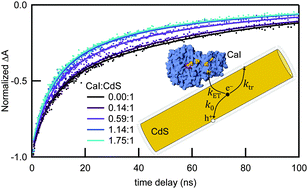Competition between electron transfer, trapping, and recombination in CdS nanorod–hydrogenase complexes†
Abstract
Electron transfer from photoexcited CdS nanorods to [FeFe]-hydrogenase is a critical step in photochemical H2 production by CdS–hydrogenase complexes. By accounting for the distributions in the numbers of electron traps and enzymes adsorbed, we determine rate constants and quantum efficiencies for electron transfer from transient absorption measurements.


 Please wait while we load your content...
Please wait while we load your content...